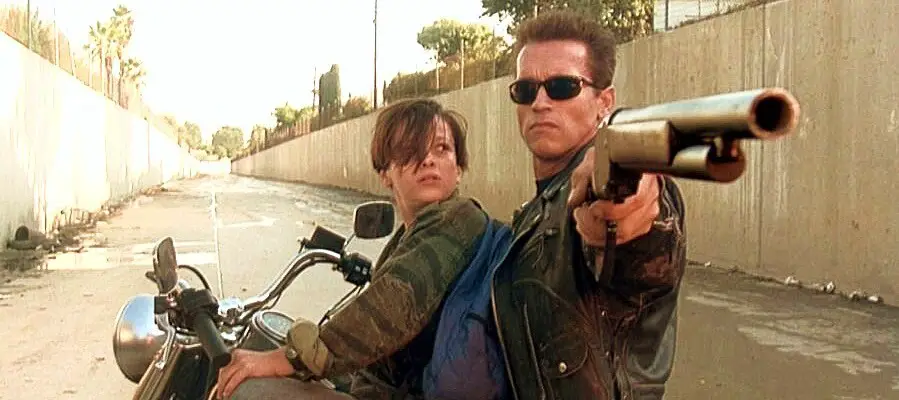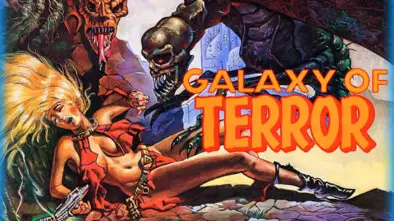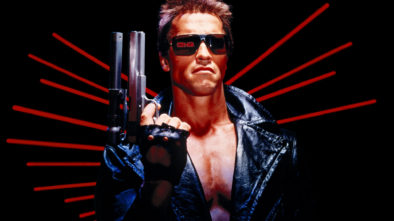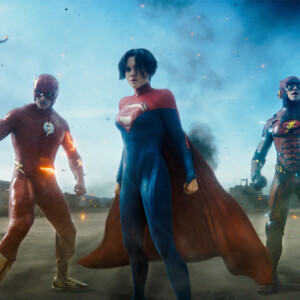The Astounding Practical Effects Of Terminator 2’s Iconic Canal Chase
Miles of cables, blowing life-size vehicles sky-high, elaborate set-pieces, and the lack of computer-generated trickery–they’re all in the wheelhouse of practical effects and stuntwork, which were used with such finesse in Terminator 2: Judgement Day. Sure, by today’s standards, practical effects placed limits on the action sequences in T2. Nonetheless, audiences still crave the thrills generated by stunts and practical effects–when they can see them. Watching stuntmen perform real stunts or narrowly miss collision with a vehicle or escape a real explosion adds a visceral element lacking in the latest DC and Marvel film.
When it comes to Terminator 2–a film that’s packed with jaw-dropping action sequences–no sequence better encapsulates this use of practical effects than the canal chase. For my money, its even better than the exceptional helicopter versus truck sequence toward the film’s end.
The canal chase introduced audiences to the relentless, seemingly indomitable power of the T-1000 (Robert Patrick). The sequence not only sets up the villain, but it also establishes the T-800 (Arnold Schwarzenegger) as John Connor’s loyal protector. Filmed in San Fernando Valley’s Bull Creek, the sequence immediately demonstrates what young John Connor (Edward Furlong) is up against and that the T-800 is now an obsolete model facing a seemingly impervious upgrade. No sequence advances the film’s plot more, while still delivering unique and impressive stunt and practical work.
Before we break down this sequence, take a few moments to refresh your memory with the sequence below:
As is now legend among film aficionados, the idea for The Terminator (1984) came to director James Cameron when he had a nightmare about an indestructible chrome torso emerging from an explosion. From this dream came the idea for Arnie’s T-800, and the rest of the plot about a cyborg sent back from the future to kill the mother of Earth’s future resistance leader, John Connor. That same dream influenced the climax of the sequel’s canal sequence: the liquid metal T-1000 emerging from a wall of fire. With the climactic moment in place, Cameron worked backwards to craft the astounding sequence.
Clocking in at over 4 minutes, the canal sequence boasts a series of impressive stunts, each totally original, and each with its own set of logistical problems. Apart from a few rear projection shots and some digital tweaking in post-production, most of the canal chase was shot practically on location in the Los Angeles Drainage Canal System. The canal chase appears to occur in one part of the canal, but it was actually filmed over ten miles. The canal is a major waterway in Los Angeles, which the production team diverted to shoot the dangerous, high-speed chase.
Shooting a chase in the close quarters of the canal was not only dangerous for the stuntmen but also for the camera crew. Cameron likes movement, and he rarely kept the camera static in Terminator 2. Special camera rigs were used to capture the action, including various camera-bikes (cameras mounted on sidecars) and various rigs that were often positioned directly in front and behind the fast-moving vehicles. Other cameras were located on top of the walled banks pointing down into the canal below, or in the canal itself. The cameramen were right there with the stuntmen, often teetering on rickety trailers and rigs; all so the audience could watch some remarkable stunt work.
Nosediving A Freightliner Semi-Tow Truck
The first major stunt involved the Freightliner taking a nose-dive off a high-rise freeway onto the dry surface of the canal below. The overpass which served as the truck’s entry point into the canal is located in North Hills, CA. To make the spectacular stunt work, the crew built a false wall for the truck to crash through. This wall also concealed a ramp that gave the semi-tow truck sufficient elevation to make its cinematic smash and crash into the canal below. See the behind-the-scenes footage for yourself.
You’d think the truck’s steering and suspension systems would end up in the driver’s lap from the impact sustained after a 20 to 30-foot drop. But somehow the truck pulls through and continues its pursuit of Connor (most likely via a separate stunt truck).
For many shots, an altered Freightliner was used to show actor Robert Patrick at the wheel. He wasn’t driving though. Concealed under the hood was the real driver at a lowered rear steering wheel. Patrick wore a mirror-image police uniform, with the final footage flipped left-to-right to make it all look right. The primary reason for shooting the footage back-to-front was due to limitations in camera placement and correct axis blocking of the shot of the truck approaching the bridge. Industrial Light & Magic added the final digital tweaks to the footage by correcting a street sign which appeared backwards in the inverted footage. Cameron praised ILM for being the first VFX company to digitally alter an image without losing quality through post-processing.
Jumping A Harley Davidson Fatboy Four Stories Down
In the canal sequence, the T-800 deftly blows the lock off an access gate with his shotgun, just moments before he takes that breathtaking jump into the canal on his Harley. The access gate–which is still intact today–is located to the left of the Freightliner’s jump point.
However, the actual jump point for the Harley Davidson is 12 miles away from this site in Sun Valley, CA. Other parts of the sequence were also filmed at this location including the ripping off of the Freightliner’s roof, and the overpass where the truck crashes and explodes in the fiery conclusion to the canal sequence.
The Harley Davidson’s jump off a culvert into the canal was the most complex element in the sequence, even though the memorable entry only lasts ten seconds. A false end was added to the culvert which provided a wider base for the bike to jump. If you look at the final footage, the Harley can be seen traveling towards the pointed end of the original culvert, but moments later you can see the blunt, square false end behind the motorcycle as it makes its jump.
Cameron made it clear he wanted the real 780-pound Harley Davidson to make the jump, not a stripped-down, lighter vehicle. Jumping a real Harley had never been attempted before. As such, the slow motion shot of a Harley Davidson Fatboy soaring through the air and careening onto the canal’s concrete surface generated its own legend. Did Arnie really perform this stunt, and without wires as the legend says? Nope. It was performed by his primary stunt double, Peter Kent, who wore facial prosthetics to look almost identical to Arnie. The shot also used a complex set of cables to make it look like a real jump.
Stunt Coordinator Joel Kramer set up two cranes left and right of the shot to ease the descent. The two cranes were 600 feet apart, with a cable strung between them. An eight-foot spreader bar was attached at the center of the cable. The Harley and Kent were then hung from the bar like a marionette. Gary Davis, another stunt coordinator and the film’s second unit director, told Motorcyclist magazine:
“Think of it [the spreader bar] as a curtain rod. Then we hung the Harley with two cables in the rear up to that curtain rod, then two cables in the front. So it just swung in the air. Then there was a third element, a fifth cable, attached to the Harley, and we would pull it along the top cable.”
The most difficult challenge was making the cabled Harley look like it was performing a real jump. But making it land is an art form in itself. In particular, Cameron wanted the Harley Davidson to have a heavy landing with sparks coming off the undercarriage as it scrapes across concrete. The bike and Kent sailed 85 feet, and right before the bike contacted with the canal floor, the cable was pulled tight so that only 180 pounds of Kent and bike made full impact with the pavement. Davis detailed the complex process further:
“..One of the tricks you have to do is not have the bike on the ground on the upper portion of the jump; otherwise, when the tires come off the ground, some weight transfers to the long cables and the bike moves strangely, and the viewer would see that…So, we kept it just a couple of inches off the ground the whole way coming in, so that way there’s no real transfer of weight when it “goes airborne” off the point of the wall. Then one of my operators on the crane would just give it a little slack and then take it up again, just so it would drop down and make contact with the ground as it ‘landed.'”
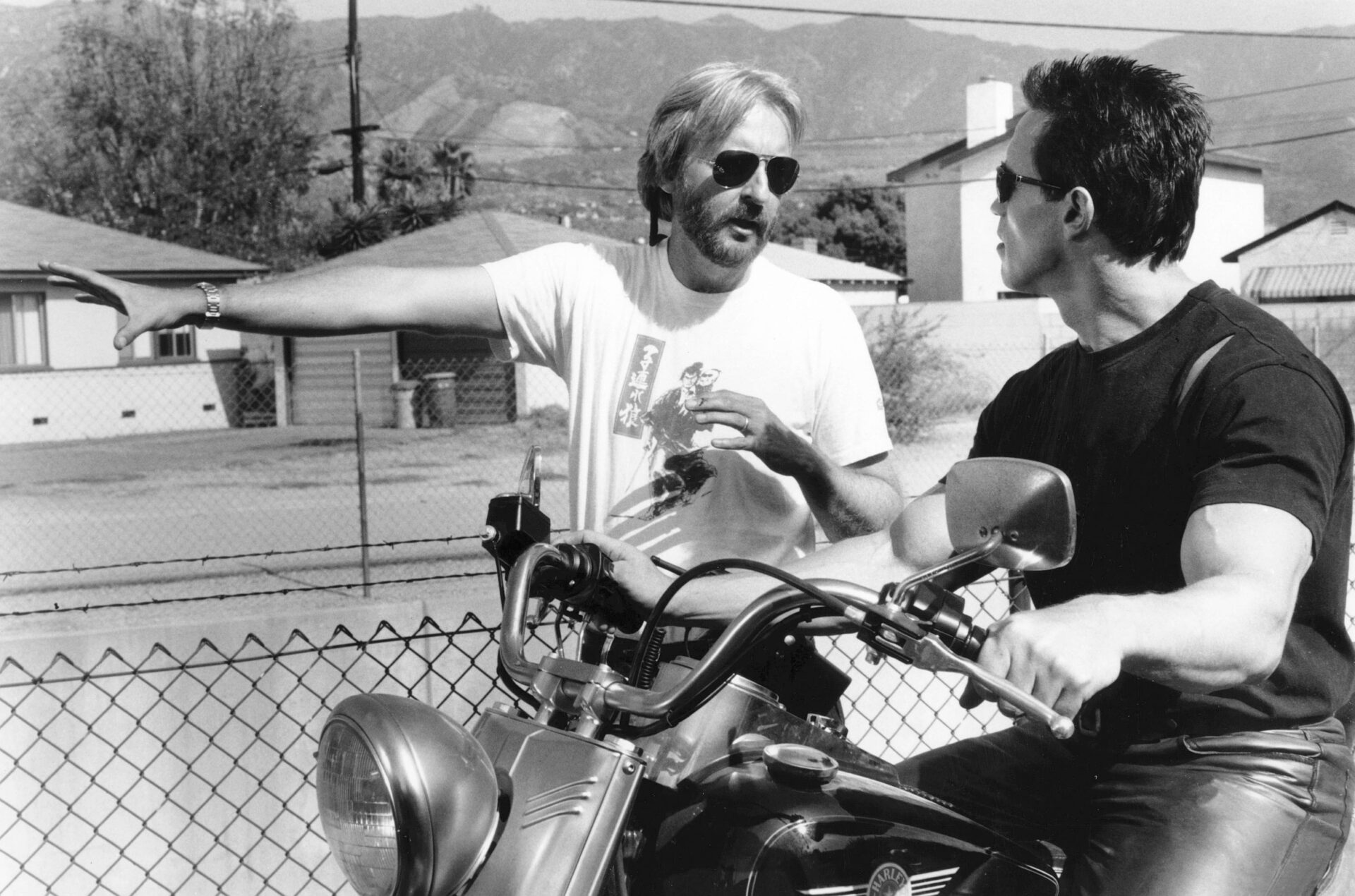
Source: Carolco Pictures, TriStar Pictures via MovieStillsDB.com
A dually pickup truck (meaning dual rear wheels on either side), which was positioned on top of the canal, towed the Harley forward via a cable fed back through the farthest crane and then back through the spreader bar to give forward motion. In previous productions, stunt coordinators used piano wire, which can snap easily. But with the advent of computers, Davis and his team could use a thicker cable that CGI erased in post-production. According to Davis, the thicker a cable, the better. Not only is it safer, but a computer can “read” it easier for deletion.
Camera-bike operator Cotton Mather drove a VMAX camera rig to film the jump from the canal below. The camera rig sat on a sidecar platform mounted to the side of Mather’s bike. “The VMAX rig lets the cameraman operate as if he’s on a camera car,” said Mather. “But with the maneuverability and speed of an MC. And the low viewpoint is crucial; it makes 30 mph look like 60. And sometimes it’s simply a case of not being able to fit a larger vehicle, which can’t speed up and slow down like I could. Also, in this case, James Cameron liked it.”
For each take, Mather started behind the Harley.
“I was able to see it up on top of the wall, and I raced ahead so that when he started to come down off the wall, I’m under him. The idea is, he winds up behind me. So, at that point, I’m fine-tuning the speed of the motorcycle, and I’m talking to a crane operator and to the guy driving the pickup towing the motorcycle from a distance—I don’t know if he could even see from there, so he’s doing it by radio. Then here’s me coming down the canal behind the Harley, which is above me and coming down. So, I follow it in, and as it comes down, I skirt in front of him so the camera, facing behind, can catch him. I did it all by eye; I looked around a lot, because he started at such a height, I couldn’t see him in the mirrors. So yeah. It was a good deal.”
Arnie’s stunt double, Peter Kent, sat on the bike rig. Kent had better bone structure than the other stuntmen, and once appliances (prosthetics) were added to his face, he looked pretty similar to Arnie. Davis and his team talked him through the sequence. He had to look like he was driving that bike off the top the culvert. There was a real danger for Kent. If something went wrong with the crane, then he could have fallen. He did hit the ground hard on that rig a few times.
Approximately 18 to 20 takes were shot. With each new take, the stunt crew either broke pieces off the bike, increased sparks, decreased sparks, or did anything to make the shot look good. Legend has it that Cameron shot the scene himself because the cameraman thought it too risky. But Davis debunked the myth, citing the safety of the stunt, and the willingness of Steadicam operator, Jimmy Muro, to film it.
Slicing Off The Truck’s Roof
As the chase continues, the Freightliner, somehow still in motion, faces another roadblock: a low-level overpass that slices off the truck’s roof. The scene emphasizes the T-100’s relentless quest to kill John Connor. But, as is often the case, this great moment was not originally planned, but arose from the constraints of the location. The crew discovered the height of the Freightliner wouldn’t fit under the 9′ 11″ clearance of the canal’s low-level bridges. So, Cameron decided to simply slice off the top of the truck as it passed underneath and as a result, the crew pre-rigged the vehicle’s roof to crumple and shear off on impact. Investigation suggests the roof’s tear off location occurred at one of two bridges near the motorcycle jump point.
Climactic Explosion
For the fiery finale of the chase, the crew used a bridge located just south of the jump-off culvert. Like, before, the crew altered the bridge to suit the parameters of the chase. They added a concrete divider, which is where the truck crashes before exploding. To protect the bridge from the impact, an overlay was put over the original concrete face of the bridge.
The final shot of the liquid metal T-1000 emerging from the wall of fire is, of course, a mix of CG elements and real-life footage. This is the first time the audience sees the T-1000 in his liquid form, and its the first time we realize this new and improved Terminator is near indestructible. And it’s also the first time audiences were introduced to the astounding possibilities of digital humans in film.
This combination of real-life footage and new, groundbreaking effects helps raise the central question that drives the rest of the plot: How will the heroes destroy something that seems so indestructible?
Cameron wanted to add the final touch of the T-800 twirling the shotgun in one hand. It’s a throwback to the old westerns. Arnie reloads his weapon with one hand while on the back of his Harley, instead of a horse. It’s a great moment which, Harry Lu, the weapons expert on T2 spent a month and a half developing. Arnie’s sawed-off 1987 Winchester 12-gauge shotgun replaces the old six-shooters in westerns. In order to be able to twirl like those old guns, Lu had to work on the shotgun’s weight distribution, balance and internal mechanism.
“It’s one of those things that the audience doesn’t think about, but the shotgun shell worked with a pull cable and every time the gate opened, the shell wants to fly out. So I finally found a way to correct that,” said Lu. The weapons expert then had to teach Arnold how to use the shotgun, and he learned pretty fast. At one point, Arnold picked up the wrong gun and almost broke his fingers as he twirled it. He just laughed it off, and carried on with the correct weapon.
The moment is a nice touch to the canal chase, which remains one of the more memorable chase sequences in film.
Sources:
Entertainment Weekly, Beyond the Marquee, Motorcycle Magazine, Top Gear, The Making of Terminator 2, Business Insider Australia, Uproxx

